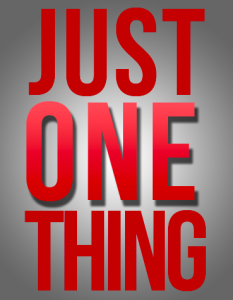 The “Just One Thing” Series at Management Excellence is intended to provoke ideas and actions around topics relevant to our success and professional growth. Use them in good health and great performance!
The “Just One Thing” Series at Management Excellence is intended to provoke ideas and actions around topics relevant to our success and professional growth. Use them in good health and great performance!
—
Why do we fail with our initiatives (projects, strategy, leadership) in the workplace so regularly when the causes of failure are well documented and the practices to minimize the chances of failure so well identified?
A student exploring project risk management was perplexed when she compared the data on project failures to the literature on risk management, only to see that the causes of failure and ideas for reducing risk were clearly identified over and over again in a nearly endless stream of articles.
I see this same situation play out repeatedly in leadership and strategy work.
The formula for leading effectively isn’t a secret kept locked in a vault with the combination known only to two people. In fact, the principles have been understood for a few millennia. And for us today in our firms, the behaviors of miserable managers and lousy leader are well understood and at last count, there were seemingly 4 quintillion resources offering input, training and help on how to lead effectively.
For strategy, too many of these programs fail not just because they were poor ideas (usually not the case), but rather because the process of execution broke down. People fail to coordinate the work necessary to properly and effectively bridge ideas to execution. While not to minimize the complexity of executing on strategy, the issues of communication, coordination, feedback, adaptation and so forth are fairly easy to grok.
Finally, when I work with people and teams in troubled organizations, I always figuratively scratch my head over the juxtaposition of relatively smart people who understand what is going wrong with the reality that few are doing anything about it.
It’s as if we have a default gear labeled “M” for mediocrity in our organizations and in ourselves. It’s the acceptance of this gear inside organizations along with the perpetuation of practices that reinforce “M” that governs our consistent and repeated sub-par performance.
However, not everyone or every team is held back by the tractor-beam pull of mediocrity.
In troubled organizations, I look for the individuals who fight back and rail against the tyranny of something that screams less than excellent. These people fight mediocrity with all of their energy and while they are often laboring in relative isolation, I strive to place them in positions of power for getting things done. From leading change initiatives to managing projects to owning big chunks of the coordination of strategy execution, these individuals have an extra gear or two beyond “M” that allows them to move people and teams faster and more effectively than the norm.
The Bottom-Line for Now:
For all of us, we have a choice to make. We can either be part of the problem or we can push ourselves to shift out of “M” and fix what’s broken and quit perpetuating the mistakes that give rise to the same advice over and over and over again. The choice is yours on what gear governs your performance. But be careful, once you shift away from mediocrity, the side effects are quite rewarding. You feel great about yourself and your work and someone somewhere who chooses people to be successful will want to create a whole new set of opportunities for you.
Is it time for you to shift out of “M” and fix what you know is broken?
—
Don’t miss the next Leadership Caffeine-Newsletter! Register here
For more ideas on professional development-one sound bite at a time, check out: Leadership Caffeine-Ideas to Energize Your Professional Development.
New to leading or responsible for first time leaders on your team? Subscribe to Art’s New Leader’s e-News.
An ideal book for anyone starting out in leadership: Practical Lessons in Leadership by Art Petty and Rich Petro.






Leave A Comment